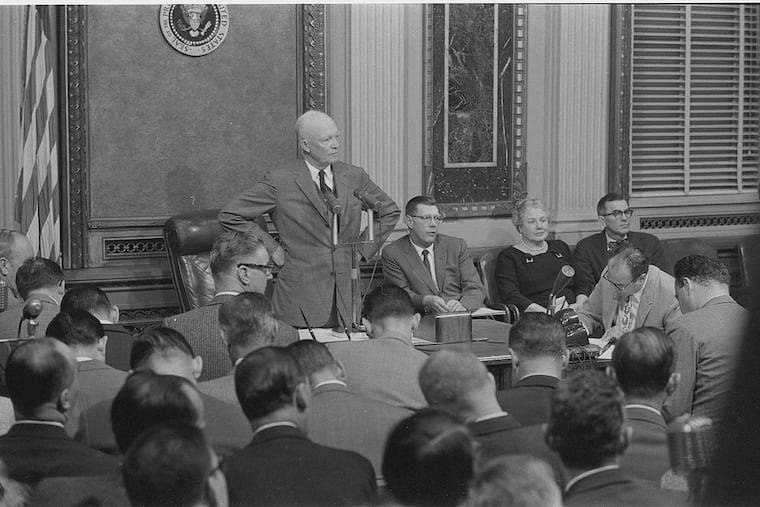Medical Mystery: What was happening to President Eisenhower?
During a White House Cabinet meeting on Nov. 25, 1957, President Dwight D. Eisenhower suddenly could not complete his sentences. He was described by his secretary as having "sudden cold feeling, dizziness, his right hand dropped his pen, could not pick up papers, words on paper ran off top of page, spoke gibberish".

During a White House cabinet meeting on Nov. 25, 1957, President Dwight D. Eisenhower suddenly could not complete his sentences. He was described by his secretary as having "sudden cold feeling, dizziness, his right hand dropped his pen, could not pick up papers, words on paper ran off top of page, spoke gibberish."
The White House physician diagnosed an abnormality of the brain's left middle cerebral artery.
After remaining in seclusion for three days, Eisenhower, who was then 67, returned to his presidential work, his speech not yet back to normal. Observers thought reporters seemed to count Eisenhower's goofs during the press conferences.
Later, Eisenhower said: "Words, but not the ones I wanted on my tongue. It was impossible for me to express any coherent thought." He was also described as leaning to one side. Yet he appeared to recover and continued as president until 1961.
Eisenhower had a long history of cardiovascular disorders starting with a surprisingly early recording of hypertension. He was first recognized as having intermittent elevated blood pressure followed by periods of normal blood pressure dating back to 1930 and 1934 as an army officer. He almost did not get promoted because of a sudden episode of hypertension recorded during a 1940 physical exam. Days later, after bed rest, he passed the exam and got his promotion to colonel.
Eisenhower's medical history, early in his presidency, included a 1955 heart attack associated with hypertension, pericarditis (inflammation of the sac surrounding the heart) and a left ventricular aneurysm. At that time, he was prescribed the blood-thinner warfarin. To complicate his presidential medical history further, Eisenhower had emergency surgery in June 1956 for a small intestinal obstruction due to Crohn's disease.
After his recovery from the 1957 cabinet meeting symptoms, the president's blood pressure intermittently spiked to 160/90 in 1959 and 190/90 in 1960. (Normal blood pressure is considered to be below 120/80.) Eisenhower had been known for sudden temper episodes and crankiness, almost as if having a chemical reaction within his body.
In later years, his blood pressure readings went as high as 245/120, and he had at least four additional heart attacks and heart failure.
What caused Eisenhower's hypertension and intermittent spiking blood pressure elevations and secondary cardiovascular complications of multiple heart attacks and stroke?
Solution
President Eisenhower's autopsy revealed a 1.5-centimeter tumor called a pheochromocytoma (PCC) in the left adrenal gland.
PCC is a neuroendocrine tumor of the inner portion of the adrenal glands, which secrete high amounts of the chemical hormones known as catecholamines, including adrenaline and noradrenaline. These hormones raise the blood pressure and stimulate heart contraction and function.
Hypertension, either sudden or sustained, is the most consistent symptom of PCC tumors, and the classical symptoms of headache, palpitations, and sweating are present in more than 50 percent of these patients. In severe cases, a patient can present with heart attack, heart failure, pulmonary edema, cardiac arrhythmias, stroke or intracranial hemorrhage.
In 1967, Marvin "Bucky" Bacaner, a researcher at the University of Minnesota, gave Eisenhower's doctors at Walter Reed Army Hospital a new investigational medicine called bretylium, which works by blocking release of the "fight or flight" hormones secreted by the adrenal glands. This stopped activation of the nervous system to prevent Eisenhower's cardiac arrhythmias, indirectly demonstrating that the president had excess adrenaline in his system.
Yet after his death, autopsy investigators found no documentation of blood or urine tests for a chemical cause of his hypertension, though testing for the catecholamines was available during Eisenhower's presidency. Clearly, no one suspected PCC as a cause of Eisenhower's blood pressure spikes and other symptoms.
Elevated test results could have led to further examinations to locate the tumor and then to surgical removal of the tumor and the affected left adrenal gland.
Allan B. Schwartz, M.D., is a professor of medicine in the Division of Nephrology & Hypertension at Drexel University College of Medicine.